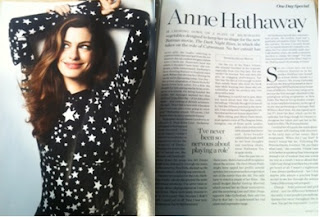I will research into various magazines within the same genre as mine (women’s lifestyle) for fashion articles. I will especially look out for any that compare different fashions, as this is what my article will do. I am going to be looking out for any language techniques used and take note of them, at the same time I will be aware of stylistics; how the pages are laid out and colour schemes, etc.
In Elle there is a selection of 4 pages which look at certain elements of fashion and compare how they can be worn. The first page is titled, “How to wear... the new white dress” Underneath the title is a kicker “It’s a summer staple, but to make the white dress modern, pick an ultra-simple style, then add sporty accessories and sunshine” In terms of image to text ratio this article is very image orientated. There is a small paragraph of text next to each image, giving prices and where the items are from. Although simple, this article is effective in that it gives a visual representation to the audience and is laid out in a very professional way. The same layout and structure is consistent throughout all four pages, this makes it appear branded to the magazine.
Another page in Elle is covered in images of fashion items that the magazine recommends. This is a singular colour scheme, which is white. There is little writing and where there is, it states the prices and stores. The following page is the same, but pastel coloured items, the page is busy, but effective.
Although the majority of fashion articles don’t have much text, there is one in Elle called, “Is this the future of fashion?” This article discusses what the future holds for fashion and whether Twitter, Tumblr and Pinterest “have the power to turn fashion from an elite club into a (very stylish) global democracy”. This article holds quite a serious tone, “The walls have come tumbling down.” However there are rhetorical questions, this will make the audience feel involved and less like they are reading a fact file. There are lighter tones, such as: “But once the genie is out of the bottle, there is no getting it back in...” The use of a fantasy/magical metaphor works well. There are a lot of quotes in this article to back up views given and they are from valid sources (which are stated in the article). This article is very text orientated.
There is an interesting article in InStyle called “Pyjamas” and it goes through the ages of fashion and the most fashionable designs of pyjamas for that era. For example, “1930’s Beach chic” Under every date is a paragraph explaining the fashion and how it was relevant at the time. The language is chatty and casual, “If you’re not brave enough to rock a set, mix ‘n’ match with jeans or a jumper.” This makes the reader feel comfortable with the ideas and is followed with: “The one golden rule? High heels.” I think this article is very interesting and is an unusual take on fashion.
Another article in this magazine is called “The Look” and it compares the fashions worn by celebrities. There is a breakout box comparing their hair styles too. This article is very image orientated article, that doesn’t require much text.


















